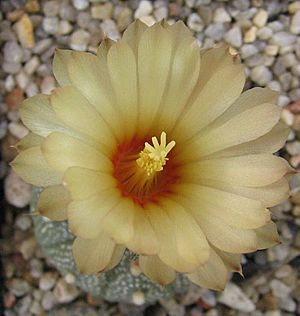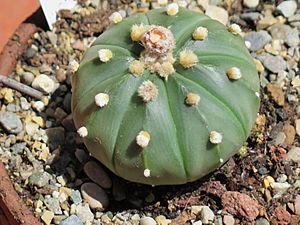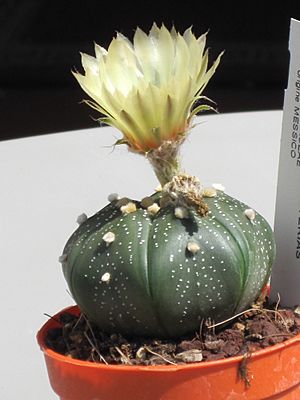Sand dollar cactus facts for kids
Quick facts for kids Sand dollar cactus |
|
|---|---|
 |
|
| Conservation status | |
| Scientific classification | |
| Genus: |
Astrophytum
|
| Species: |
asterias
|
The Astrophytum asterias, also known as the Star Cactus, is a special type of cactus. It grows naturally in small areas of Texas in the United States and Mexico. People also call it the sand dollar cactus or sea urchin cactus because of its shape.
Contents
What is the Star Cactus?
The Star Cactus is small and round. It does not have spines. It usually grows to be about 2.5–6 cm (0.98–2.36 in) tall. It can be 5–15 cm (2.0–5.9 in) wide. Its body looks like a disc. It has 7 to 10 sections, which are called ribs. In the middle of each rib, there are fuzzy spots. These spots are called areoles.
The cactus is a greenish-brown color. It might look speckled. This is because it has tiny white scales on its surface. The flowers of this cactus are yellow. They have red parts at their base. The outside of the flowers is very fuzzy. After flowering, the cactus makes oval fruits. These fruits are green to pink. They are also covered with fuzzy hairs.
How Does it Grow? (Life Cycle)
Star Cacti reproduce by cross-pollination. This means they need pollen from another Star Cactus. They become old enough to reproduce after a few years. This happens when they are about 2 to 3 cm wide.
Flowers appear from March to June. This is during the summer in their natural home. The fruits grow from April to June. We don't know exactly which insects pollinate them. But insects are thought to help them reproduce.
The Star Cactus looks very similar to another plant. This plant is called Euphorbia obesa. Even though they look alike, Euphorbia obesa is not a cactus. It is a succulent plant.
Where Does it Live?
The Star Cactus is found in the lower Rio Grande Valley of Texas. It also lives in parts of Nuevo León and Tamaulipas in Mexico. These areas are east of the Sierra Madre Oriental mountains.
This cactus used to be found in many more places. Now, in Texas, it lives in only one main area. This area is about 200 acres. There are around 2,000 Star Cacti there. There are also a few small groups in Tamaulipas, Mexico.
Today, these cacti grow in thorny scrubland. They are often found among rocks. They might have once lived in flat, grassy areas. But these areas have now been developed. The Star Cactus has likely disappeared from Nuevo León.
Growing Star Cacti at Home
People have grown the Sand Dollar Cactus as a houseplant since the 1840s. This is true for other cacti in its group too. Even though it is rare in the wild, it is easy to grow from seeds. So, most plants you see in stores were grown from seeds.
Many people like to collect these cacti. This has led to different types, called cultivars. One popular type is 'Super Kabuto'. This type has large fuzzy spots. These spots are grouped together in a cool pattern.
Protecting the Star Cactus
The Star Cactus grows slowly. Because of this, it is listed as an endangered species by the United States Fish and Wildlife Service. It is also listed as vulnerable by the International Union for Conservation of Nature (IUCN). This means it is at risk of disappearing.
It is also protected by CITES (Convention on International Trade in Endangered Species). This rule means that people cannot buy or sell wild Star Cacti across countries. Even with these rules, some people still collect them illegally. This is a big threat to the cactus.
One reason for its decline is that people take too many from the wild. Sometimes, it is accidentally collected. This happens because it looks like another cactus called peyote (Lophophora williamsii). Other problems include city growth and chemicals used on plants.
The biggest reason for the decline is habitat loss. Large areas where the cactus lives have been turned into farms. Roads have also been built. In Texas, machines and chemicals are used to clear bushes. New types of grass have also been brought in. All these things have harmed the Star Cactus.
The United States Fish and Wildlife Service has a plan to help this cactus. This plan aims to protect the cacti that are still left. It also wants to find new groups of them. The plan also hopes to create an agreement between the United States and Mexico. This agreement would help protect the Star Cactus together.
See also
 In Spanish: Astrophytum asterias para niños
In Spanish: Astrophytum asterias para niños






